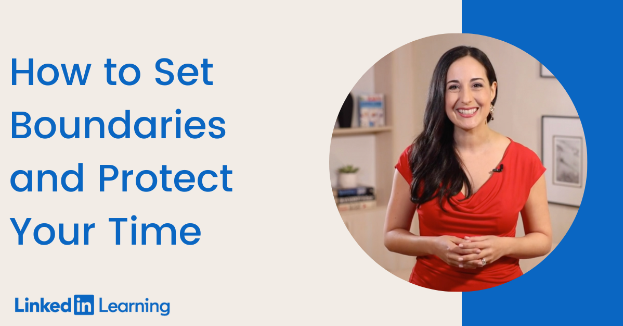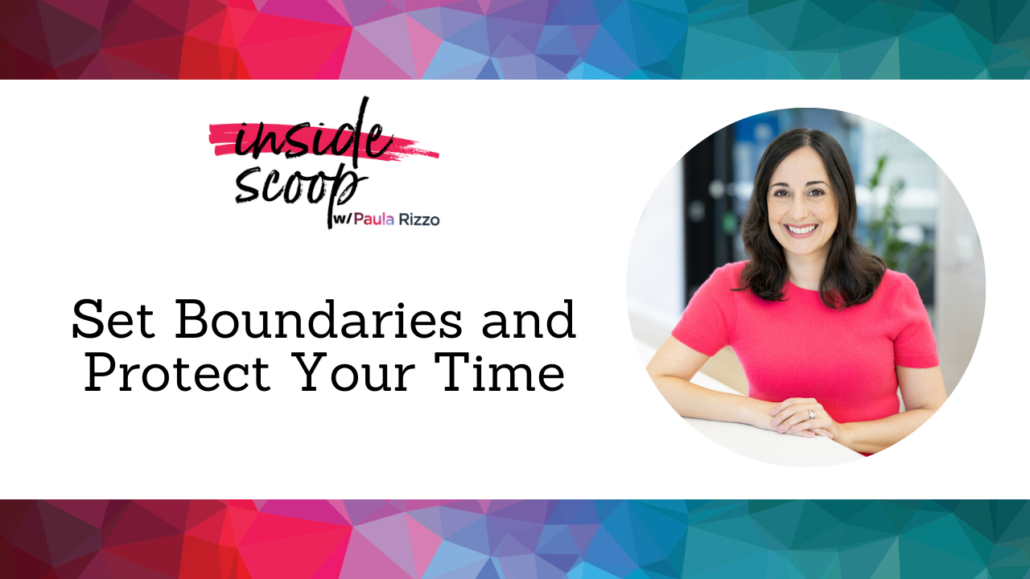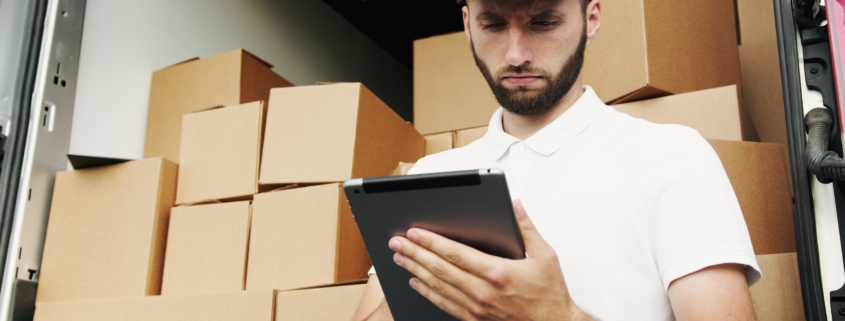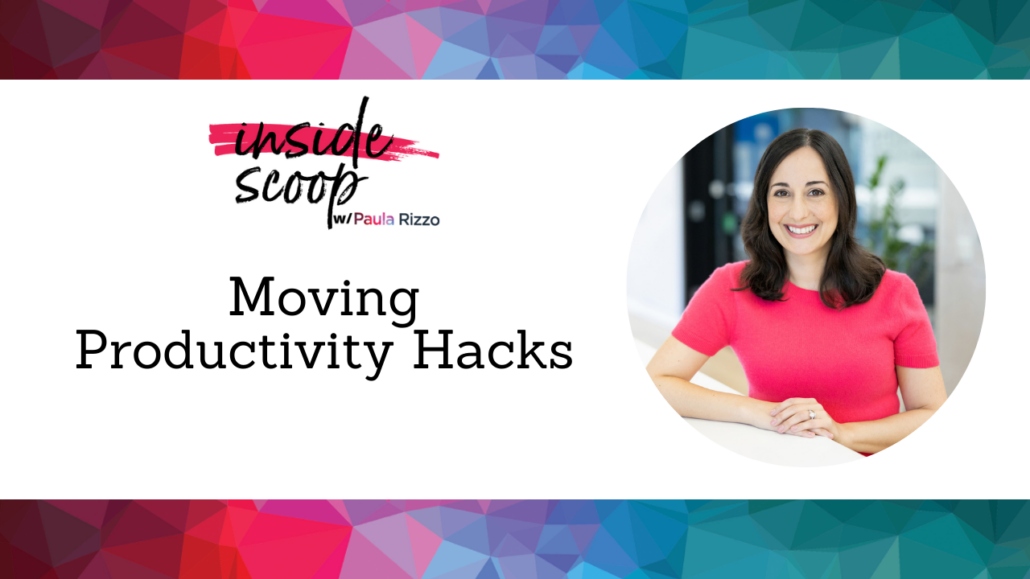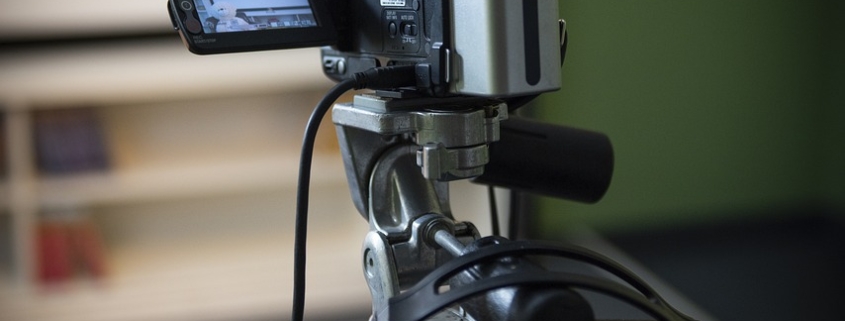How To: Setting Boundaries
___
BONUS FREEBIE: Want even more ways to stay organized, productive and less stressed? Click here to get access to my List-Making Starter Kit. It will boost your efficiency and get you back to doing more of the things you love.
___
When was the last time you did something because you didn’t want to let someone down? Whether your boss or friend or family member, so many of us have given in to people pleasing at one time or another.
And it just feels yucky.
Setting boundaries is something that should be covered in college — high school even! — because it takes a lot of practice to get good at it.
It’s not (yet) a universal skill.
Well, I want to help you out. I created a whole course on LinkedIn Learning about setting boundaries and today I’m spilling the beans.
I go into detail in a recent episode of Inside Scoop about the course so you can get a preview of what you’ll be learning.
When LinkedIn approached me about making a course on boundaries I was so excited. I know this is something that people can struggle with, and over the years as a journalist and producer, and now as a media trainer and author, I’ve found so many benefits to setting boundaries.
So in this episode of Inside Scoop I want to share some of the strategies I talk about in my How to Set Boundaries and Protect Your Time course.
The Case for Protecting Your Time
Think about how your time is best spent. When you start protecting your time, how will you spend it?
Years ago when I worked in a newsroom I was invited to a wedding along with all of my colleagues. Sure, I wanted to go and support my colleague, even though we weren’t that close.
So instead of instantly responding “yes” I paused and thought about how else I could spend that time.
Instead of the wedding I went to a Broadway show with my mom and loved it! We had the best time.
When you start thinking about time as yours it can be easier to put your needs first.
Time Tracking 101
How long do you spend scrolling through Instagram every day. Seriously, you should check.
Or the last time you attended a meeting that was scheduled for 30 minutes and ran for 52?
Before you can protect your time, you need to know where your time is going. How it’s being spent. You can do this by chunking out your time. List what you did today and how long it really took you (not the idealized time!). Think about which things were most rewarding and which were most soul-sucking.
List these out on two separate lists – the rewarding activities and the time sucks.
Setting Your Own Personal Boundaries
This is something I talk about often in my books, Listful Thinking and Listful Living. How do you work best?
For instance, I block out my days in a specific ways. Mondays are for writing and getting ready for the week. I don’t take meetings on Mondays. Tuesdays, Wednesdays and Thursdays are business focused. I produce Inside Scoop, meet with media training clients, speak to groups, and get business admin stuff done. Then Fridays are for creativity. I’m working on a novel and that’s when I’ve written most of it – on Fridays.
Make some rules for yourself. And stick to them.
Strategies to Stay On Track
In this LinkedIn Learning course I share a few scripts on how to say no, what to say instead, and how to feel good about it while staying accountable to your rules.
It’s easy to think about making changes and setting healthy boundaries, but it can be hard to do in practice.
So, as you journey off to set your own boundaries remember that just because you can does not mean you should.
There’s, of course, much more to learn in the full course, you’ll find it on LinkedIn Learning here.
___
BONUS FREEBIE: Want even more ways to stay organized, productive and less stressed? Click here to get access to my List-Making Starter Kit. It will boost your efficiency and get you back to doing more of the things you love.
___
Six Moving Hacks to Make You Less Stressed
___
BONUS FREEBIE: Want even more ways to stay organized, productive and less stressed? Click here to get access to my List-Making Starter Kit. It will boost your efficiency and get you back to doing more of the things you love.
___
Moving is one of those things that seems destined to be stressful. It can be emotional, hectic, unpredictable, chaotic… you get it. But what if it didn’t have to be that way?
I’ve moved two times in the past year, and I want you to know that it is possible to make moving a little easier.
Here are my moving hacks:
1. Set yourself up for success.
The truth is that you probably have a ton of stuff in your home right now that you don’t use and don’t need. And when you’re actually packing up to move, you may not have time to be making decisions about what to save, what to toss, and how to organize what you’re keeping. You can set yourself up for so much less anxiety if you organize and get rid of what you don’t need before it’s time to pack.
In fact, before my husband and I moved out of the Manhattan apartment we’d lived in for almost ten years, we hired professional organizers to help us get everything in order. We used Swoon Spaces and they made our lives so much easier. Once we’d pared down to the essentials, it was so much easier to find and use everything. We spent about five hours with the organizers and when they left, they took all the things we decided not to keep and donated them for us. Doing this ahead of time means you’re moving less stuff, unpacking less stuff, and you’re not buying things you don’t need or can’t find.
Check out the recent television interview I did with PIX11 News in NYC with my best tips for moving.
2. Chunk your tasks — and be realistic.
This comes from my time as a TV producer. I would always work backward from the deadline for a segment going on air. It’s the same for moving. Once you know your moving day, you can begin creating lists with respect to all the deadlines — calling the movers, reserving an elevator if you live in an apartment building, etc.
Then, aim to give yourself (and other people who are involved with the move) a couple of things each day. These should be realistic tasks that you can actually get done in the time you have.
3. Get out ahead.
When I moved from Miami back to New York, I shipped a bunch of things ahead of time with a company called Lug Less. They ship luggage and you can just fill up a suitcase and send it off. The only thing to note is that the luggage actually arrived a little ahead of schedule — just something to factor in.
5. Label everything.
Whether or not you hire movers, make sure that your boxes are labeled by room. If you do have movers, like I did, having color-coded sticky notes on each box (green for the kitchen, etc.) means that your movers won’t have to ask you where each box goes. I set up a little key on the wall with the color for each room and that meant I was freed up to work on other tasks while the movers went to work. The movers loved it too!
I also went a step further and made a searchable spreadsheet noting what was in each box. So for example, if I needed a spatula, I could search “spatula” in my spreadsheet and find that exact box it was in. That made things so much easier in the first few days!
6. Sort by “need now” and “need later.”
When you move, there will be some items you need right away and others that you won’t need for weeks or months. Labeling boxes by priority was another way I made sure I could easily access the most important things without having to open every single box.
Another way I made things easier on myself was by packing overnight bags. That way, my husband and I had a few days worth of clothes and essentials so that we had what we needed separate from all the boxes.
7. Optimize your space.
One of the best things I did before I moved was hire a virtual designer. It was more affordable than you might think! I used a company called Havenly. You send them the dimensions of the room and what you’re using it for, and they help you think about furniture and arrangements. This really helped me figure out what pieces should go where — and what I needed to buy to make it work for my needs. And don’t think you need to own a home to invest in this kind of service. I’m renting right now and it was so useful in helping me make the most of my office.
Whether you just want some professional advice on storage or you need people to come in and actually install a whole organization system (which I did when I owned an apartment in NYC!), I highly recommend having a professional help you optimize your space. It’s so worth it in the long run!
Check out the entire episode of Inside Scoop here for more on how to make your move less stressful!
___
BONUS FREEBIE: Want even more ways to stay organized, productive and less stressed? Click here to get access to my List-Making Starter Kit. It will boost your efficiency and get you back to doing more of the things you love.
___
How a LinkedIn Learning Course Is Made
___
BONUS FREEBIE: Want even more ways to stay organized, productive and less stressed? Click here to get access to my List-Making Starter Kit. It will boost your efficiency and get you back to doing more of the things you love.
___
After almost two decades as a TV producer, I’m now in front of the camera as an expert on productivity and media. I’ve been creating LinkedIn Learning courses for the past few years, and this summer I got to go to the beautiful town of Carpinteria, California to shoot two new courses!
They are called Redefining Your Productivity in the Future of Work and Overcome the Productivity Perception Gap as a Manager.



